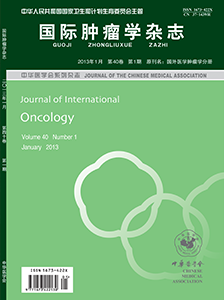Therapeutic effect and mechanism of regulating cellular immune function of chemotherapy combined with PD-1 inhibitor in the first-line treatment of Lewis xenografts
引用次数: 0
Abstract
Objective To investigate the efficacy of chemotherapy combined with programmed death-1 (PD-1) inhibitor in the first-line treatment of Lewis xenografts and its possible mechanism of regulating cellular immune function. Methods Lewis xenografts mouse model was established. The mice were randomly divided into control, chemotherapy, immunotherapy and combination group according to the method of random number table (10 in each group), and each group separately received saline, cisplatinum, PD-1 inhibitor and cisplatinum combined with PD-1 inhibitor. The tumor growth and survival of each group were observed. Flow cytometry was used to detect and compare the proportion of CD8+ T cells and CD4+ CD25+ FOXP3+ regulatory T cells (Treg cells). Results On the second day after treatment, the tumor volume of Lewis xenografts in control group, chemotherapy group, immunotherapy group and combination group were (1 662.0±209.0) mm3, (1 189.2±155.6) mm3, (991.1±146.6) mm3 and (761.7±141.8) mm3, with statistically significant difference (F=29.78, P<0.001). The tumor volume in the three treatment groups were significantly smaller than that in control group, combination group was significantly smaller than chemotherapy group and immunotherapy group, and immunotherapy group was significantly smaller than chemotherapy group (all P<0.05). Three mice died during the experiment (two in control group and one in chemotherapy group). The median survival time of mice in the four groups were 10, 12, 14 and 18 days, with statistically significant difference (χ2=26.06, P<0.001). The median survival time of mice in the three treatment groups were significantly longer than that in control group, combination group was significantly longer than chemotherapy group and immunotherapy group, and immunotherapy group was significantly longer than chemotherapy group (all P<0.05). The proportions of CD8+ T cells in the peripheral blood of the four groups were (28.5±1.2)%, (33.9±2.9)%, (34.0±2.5)% and (42.4±1.5)%, with statistically significant difference (F=21.32, P<0.001). The proportions of CD8+ T cells in the peripheral blood of the three treatment groups were significantly higher than that of control group, and combination group was significantly higher than chemotherapy group and immunotherapy group (all P<0.05). The proportions of CD8+ T cells in the tumor microenvironment of the four groups were (23.5±1.3)%, (26.7±1.4)%, (34.2±2.8)% and (41.3±2.0)%, with statistically significant difference (F=61.65, P<0.001). The proportions of CD8+ T cells in the tumor microenvironment of the three treatment groups were significantly higher than that of control group, combination group was significantly higher than chemotherapy group and immunotherapy group, and immunotherapy group was significantly higher than chemotherapy group (all P<0.05). The proportions of CD4+ CD25+ FOXP3+ Treg cells in the spleen of the four groups were (8.6±0.5)%, (7.2±0.3)%, (6.3±0.4)% and (5.4±0.4)%, with statistically significant difference (F=37.06, P<0.001). The proportions of CD4+ CD25+ FOXP3+ Treg cells in the spleen of the three treatment groups were significantly lower than that of control group, combination group was significantly lower than chemotherapy group and immunotherapy group, and immunotherapy group was significantly lower than chemotherapy group (all P<0.05). Conclusion Chemotherapy and PD-1 inhibitor can enhance the anti-tumor effect of the body immune system by down-regulating the proportion of Treg cells and up-regulating the proportion of CD8+ T cells, etc. Chemotherapy combined with immunotherapy can improve the anti-tumor immune function, inhibit tumor growth and prolong the survival of mouse with xenograft, which were significantly better than chemotherapy and immunotherapy alone. Key words: Lung neoplasms; Drug therapy; Immunotherapy; T-lymphocyte subsets; PD-1化疗联合PD-1抑制剂一线治疗Lewis异种移植物的疗效及调控细胞免疫功能的机制
目的探讨化疗联合程序性死亡-1 (PD-1)抑制剂一线治疗Lewis异种移植物的疗效及其调控细胞免疫功能的可能机制。方法建立小鼠Lewis异种移植模型。将小鼠按随机数字表法随机分为对照组、化疗组、免疫治疗组和联合组(每组10只),每组分别给予生理盐水、顺铂、PD-1抑制剂和顺铂联合PD-1抑制剂。观察各组肿瘤生长及存活情况。流式细胞术检测并比较CD8+ T细胞与CD4+ CD25+ FOXP3+调节性T细胞(Treg细胞)的比例。结果治疗后第2天,对照组、化疗组、免疫治疗组、联合治疗组Lewis异种移植物肿瘤体积分别为(1 662.0±209.0)mm3、(1 189.2±155.6)mm3、(991.1±146.6)mm3、(761.7±141.8)mm3,差异有统计学意义(F=29.78, P<0.001)。3个治疗组肿瘤体积均显著小于对照组,联合治疗组肿瘤体积显著小于化疗组和免疫治疗组,免疫治疗组肿瘤体积显著小于化疗组(均P<0.05)。实验期间死亡3只小鼠(对照组2只,化疗组1只)。四组小鼠的中位生存时间分别为10、12、14、18 d,差异均有统计学意义(χ2=26.06, P<0.001)。3个治疗组小鼠的中位生存时间均显著长于对照组,联合治疗组显著长于化疗组和免疫治疗组,免疫治疗组显著长于化疗组(均P<0.05)。四组患者外周血CD8+ T细胞比例分别为(28.5±1.2)%、(33.9±2.9)%、(34.0±2.5)%、(42.4±1.5)%,差异均有统计学意义(F=21.32, P<0.001)。3个治疗组外周血CD8+ T细胞比例均显著高于对照组,且联合治疗组显著高于化疗组和免疫治疗组(均P<0.05)。四组肿瘤微环境中CD8+ T细胞的比例分别为(23.5±1.3)%、(26.7±1.4)%、(34.2±2.8)%和(41.3±2.0)%,差异均有统计学意义(F=61.65, P<0.001)。3个治疗组肿瘤微环境中CD8+ T细胞比例均显著高于对照组,联合治疗组显著高于化疗组和免疫治疗组,免疫治疗组显著高于化疗组(均P<0.05)。四组小鼠脾脏CD4+ CD25+ FOXP3+ Treg细胞比例分别为(8.6±0.5)%、(7.2±0.3)%、(6.3±0.4)%、(5.4±0.4)%,差异均有统计学意义(F=37.06, P<0.001)。3个治疗组脾脏CD4+ CD25+ FOXP3+ Treg细胞比例均显著低于对照组,联合治疗组显著低于化疗组和免疫治疗组,免疫治疗组显著低于化疗组(均P<0.05)。结论化疗及PD-1抑制剂可通过下调Treg细胞比例、上调CD8+ T细胞比例等途径增强机体免疫系统的抗肿瘤作用。化疗联合免疫治疗可提高异种移植小鼠的抗肿瘤免疫功能,抑制肿瘤生长,延长生存期,明显优于化疗联合免疫治疗。关键词:肺肿瘤;药物治疗;免疫治疗;早期肠;PD-1
本文章由计算机程序翻译,如有差异,请以英文原文为准。
求助全文
约1分钟内获得全文
求助全文

 求助内容:
求助内容: 应助结果提醒方式:
应助结果提醒方式:


